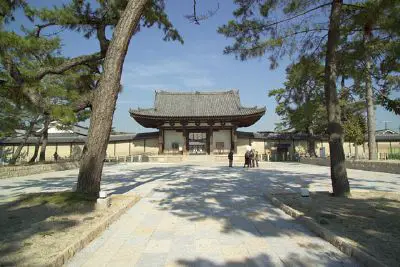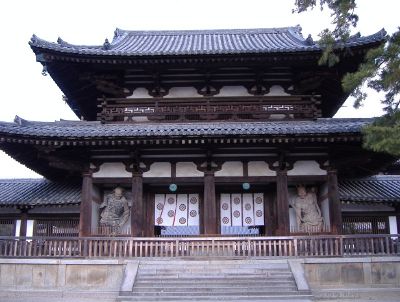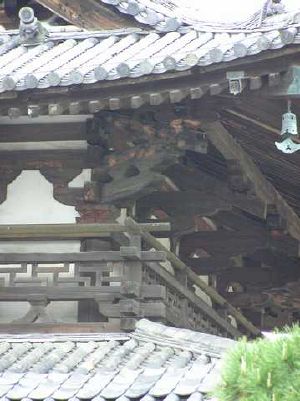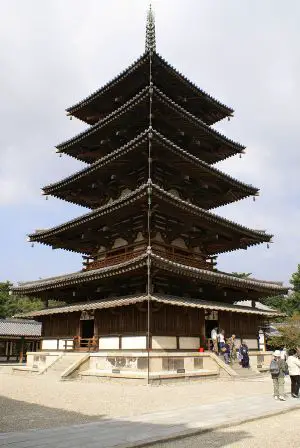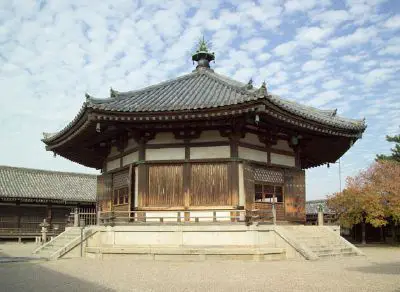| Buddhist Monuments in the Horyu-ji Area* | |
|---|---|
| UNESCO World Heritage Site | |
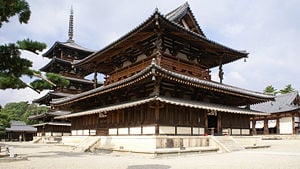
| |
| State Party | |
| Type | Cultural |
| Criteria | i, ii, iv, vi |
| Reference | 660 |
| Region** | Asia-Pacific |
| Inscription history | |
| Inscription | 1993 (17th Session) |
| * Name as inscribed on World Heritage List. ** Region as classified by UNESCO. | |
Hōryū-ji (法隆寺; Temple of the Flourishing Law) is a Buddhist temple in Ikaruga, Nara Prefecture, Japan. Its full name is Hōryū Gakumonji (法隆学問寺), or “Learning Temple of the Flourishing Law,” because the site serves as a seminary as well as a monastery. The temple is widely acknowledged to have some of the oldest wooden buildings in the world, and is one of the most celebrated temples in Japan.[1][2] Hōryū-ji was originally built in 607 by Empress Suiko and Crown Prince Shotoku, to fulfill a vow made by Emperor Yomei during his final illness. A fire in 670 destroyed the original buildings, but a reconstruction was completed in 711 and new structures were continually added to the temple through the nineteenth century. Hōryū-ji represents 14 centuries of uninterrupted observance of Buddhist tradition, and is considered a living history of the development of Buddhism in Japan.
Hōryū-ji contains over 2300 important cultural and historical structures, art treasures and artifacts. In 1993, Hōryū-ji was one of 48 Buddhist monuments designated a UNESCO World Heritage Site. Many of the temple’s 45 buildings are listed as National Treasures by the Japanese government.
Buddhist monks have continuously offered spiritual devotions and engaged in religious practices there for 14 centuries through the present. This continual history of spiritual devotion and religious practice makes Horyuji a unique temple among other Buddhist temples.
History
The story of Hōryū-ji's founding is inscribed on the back of the halo of the Yakusi Nyorai Buddha statue, located in the temple's Main Hall, and recorded in an official inventory of Hōryū-ji property prepared in 747. According to these records, shortly before his death in 587, the emperor Yomei made a vow to build a temple and an image of the Buddha as a prayer for his recovery from an illness. In 607, his sister, Empress Suiko, and his son, Crown Prince Shotoku fulfilled Emperor Yomei's deathbed vow by building a temple and erecting a statue of a Buddha, the Yakusi Nyorai (Bhaisajyaguru; literally, "arrival as a healer") to which it was dedicated.[2] The temple was named Ikaruga-dera (斑鳩寺) for the site where it was located, a name that is still sometimes used.
The ancient Chronicles of Japan (Nihon Shoki) report that on the night of April 30 in the year 670, a great blaze swept through the temple grounds, leaving "not a single building standing." A long controversy, ignited by the architectural historian Sekino in 1905, questioned whether the temple actually burned down at all. Excavations carried out in 1939 confirmed that Prince Shotoku's palace, the Ikaruga-no-miya (斑鳩宮), occupied the eastern part of the current temple complex, where the Tō-in (東院) sits today.[3] Also discovered were the ruins of a temple complex which was southwest of the prince's palace and not completely within the present temple complex.[3] The original temple, named Wakakusa-Garan (若草伽藍) by modern historians and archaeologists, was lost, and a reconstruction, slightly reoriented in a northwest position, is believed to have been completed by around 711, before the imperial court moved to Kyoto.[4] The older temple site includes architectural remains of a Kondo and a pagoda, which are accepted as conclusive proof that the present temple is a reconstruction. There is still a debate as to whether a fire actually occurred in 670, or whether there was another reason for the reconstruction.[5]
Four structures erected during that reconstruction, including a five-story pagoda, the chu-mon (“middle gate”), part of the enclosing rectangular corridor, and the kondo (“main hall”), have survived and are among the oldest wooden structures in the world.
The temple was repaired and reassembled in the early twelfth century, in 1374, and in 1603.[6]
Architecture
The present complex
The current temple grounds occupy 187,000 square meters and are made up of two areas, the Sai-in (西院) in the west, containing the Kondō (金堂, Golden Hall) and the temple's five-story pagoda; and the Tō-in (東院) 122 meters east of the Sai-in area, arranged around the octagonal Yumedono Hall (夢殿, Hall of Dreams). The complex contains 45 buildings, including monk's quarters, lecture halls, libraries, and dining halls.
Hōryū-ji represents 14 centuries of uninterrupted observance of tradition, and the structures, which were added from the seventh through the nineteenth century, are considered a living history of the development of Buddhism in Japan.
Characteristics
The buildings reconstructed after the first temple burned down embrace a range of architectural influences, from Eastern Han to Northern Wei of China, and the Three Kingdoms of Korea, particularly those of Baekje. The early seventh century reconstruction features a unique fusion of early Asuka period (538 – 710) style elements with some distinct elements only found in Hōryū-ji, that were not seen again in the architecture of the following Nara period.
Certain features suggest that the current precinct of Hōryu-ji is not simply representative of the pure Asuka style, but combines a series of evolving styles.[7]One of the most notable of these features is Hōryū-ji’s layout. While most Japanese temples built during the Asuka period were arranged like their Chinese and Korean prototypes, with the main gate, a pagoda, the main hall and the lecture hall on a straight line, the reconstructed Hōryū-ji broke from those patterns by arranging the Kondō and pagoda side-by-side in the courtyard.[7]
Another variation, discovered through the excavations of the Yamada-dera, a lost temple originally dated 643, is a difference in the style of the corridor. Yamada-dera had thick horizontal poles placed close together in the windows, while those at Hōryū-ji are thinner, and spaced at larger intervals.
Major Asuka style characteristics seen in Hōryu-ji, and resembling designs found in the Yungang Grottoes (Northern Wei), are the entasis columns, and the railings, decorated with repeat-patterned Buddhist swastika (卍字崩し高欄 manji kuzushi koran), above inverted "V" shape supports (人字形割束 ninji gata warizuka). Another notable Asuka style element, found only in Japan, is a cloud-shape hybrid bracket supporter (a 組物 kumimono; (hybrid) of 雲斗 kumoto and 雲肘木 kumohijiki). The only surviving originals are in Hōryu-ji. These characteristics of Asuka style are not seen in Nara period temples.
Pagoda
The five-story pagoda, located in the Sai-in area, stands 32.45 meters (106.5 ft) in height and is regarded as one of the two oldest wood buildings in the world. A dendrochronological analysis has shown that the tree used in the central pillar of the pagoda was probably felled in 594.[4] The pillar is set three meters below the surface of the massive foundation stone, extending into the ground. Further below is a hollow for relics, containing a reliquary. The reliquary was briefly salvaged from the hollow, then replaced during a reconstruction of the pagoda for reconditioning in the 1950s.[5] Although the pagoda is five-storied, it is not designed to be ascended from the inside, but is intended to inspire people with its external view.[8]
Kondō
The Kondō, located beside the Pagoda in Sai-in, is considered to be the other of the two oldest wood buildings extant in the world.[7] The hall, measuring 18.5 meters (61 ft) by 15.2 meters (50 ft), is two-storied, with roofs curved in the corners, but only the first story has a double roof (裳階 mokoshi). This was added later in the Nara period, with extra posts to hold up the original first roof, which extended more than four meters past the building.
A fire, caused by a malfunctioning electric heated cushion on January 26, 1949, caused severe damage to the building, primarily to its first floor, and the murals. As a consequence of the restoration (completed in 1954), it is estimated that about fifteen to twenty percent of the original seventh century Kondō materials is left in the current building. The charred sections were carefully removed and rebuilt in a separate fireproof warehouse for future research.[6][9] A dendrochronological analysis carried out on the wood salvaged from the fire revealed that some of the trees were felled prior to 670, suggesting a possibility that the current Kondō was already under construction when the fire in 670, recorded in the Nihon Shoki, burned down the former Wakakusa-Garan.[10]
Though not large, the hall is very impressive, with its multi-layered roof, sweeping eaves, and intricately detailed second floor banister. The hall holds the famous Shaka Triad, together with bronze Yakushi and Amida Nyorai statues, and other national treasures. The wall paintings shown today in the Kondō are mounted reproductions, made in 1967 by artists copying, on white paper, large format color photographs that had been taken of the murals before the fire.
Yumedono (Hall of Dreams)
Yumedono (“Hall of Dreams,” or “Hall of Visions”), an elegant octagonal building, is one of the main constructions in the Tō-in area, built on the ground which was once Prince Shōtoku's private palace, Ikaruga no miya. The present incarnation of this hall was built in 739 to assuage the Prince's spirit. The hall acquired its present-day common name in Heian period, from a legend that says a Buddha arrived as Prince Shōtoku and meditated in a hall that existed here. The hall contains the famous Yumedono Kannon (also Guze,- Kuse-, or Guze Kannon); which is only displayed at certain times of the year.[11]
The Tō-in area also contains the Denpodo (a lecture hall), and priests' living quarters dating to the eighth century. The corridor surrounding Yumedono; the Raido (worship hall); and other buildings were rebuilt in the thirteenth century.
Treasures
Hōryū-ji contains over 2300 important cultural and historical structures and artifacts, including nearly 190 that have been designated by the Japanese government as National Treasures or Important Cultural Properties. In December of 1993, Hōryū-ji, as a unique storehouse of world Buddhist culture, became the first treasure of any kind in Japan to be selected by UNESCO as part of the World Heritage.
The treasures of the temple are considered to be a time capsule of Buddhist art from the sixth and seventh century. Many of the frescoes, statues, and other pieces of art within the temple, as well as the architecture of the temple's buildings themselves, exhibit a strong cultural influence from China, Korea, and India, and illustrate the cultural links among the countries of East Asia.[3]
A large quantity of these objects were moved in the 1880s to the Horyu-ji Treasure House on the grounds of the Tokyo National Museum. In 1941, commemorating the 1,350th anniversary of the death of Shotoku, a museum was built in Ikaruga to house other works of art, religious objects, and artifacts found in the monuments of the region.
The Hōryū-ji Treasure House on the grounds of the Tokyo National Museum holds over 300 objects which were donated to the Imperial Household by Hōryu-ji in 1878. Some of these items are on public display, and all are available for study as part of the museum's digital collection.[12]
Murals
The murals of the Kondō comprise 50 walls; four larger walls, eight mid-sized walls and 38 small wall areas inside the building. The original murals were removed after the fire incident in 1949, and are kept in a treasure house that is not open to the public. Twenty small wall paintings that escaped the 1949 fire, are in their original places, and reproductions have replaced the damaged murals that were removed.
It is generally believed that the paintings on the large walls represent the Pure Land (浄土 jodo) with Shaka, Amida, Miroku and Yakushi Nyorai Bhuddas. Some of the features and clothing in the paintings bear similarities with murals found in the Ajanta Caves (India) or in Dunhuang (China). Tang and Indian influences can be observed in the Bosatsu and Kannon painted alongside the Amida.
Based on the evidence of early Tang influences, present-day consensus is that these paintings were created at the end of seventh century. This rules out the possibility that they were painted by the early seventh century figures who were once believed to be their creators, such as Tori or Doncho (a Goguryeo monk Tamjing, who lived in Ikaruga). No person is clearly credited as the painter of these works.[13][5]
Kudara Kannon
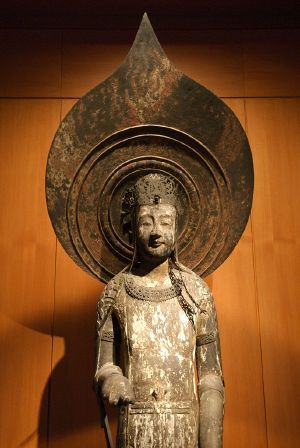
The Kudara Kannon is a statue of Kannon, 2.1 meters (6.9 ft) in height, made of gilded camphor wood[14] and shouldering a halo. The slender, graceful statue is unique in Japanese art,[2] and is regarded as one of the most important works of Buddhist art from ancient Japan.
The statue is very thin, creating the illusion of height. “Kudara” was the Japanese name for the Baekje Kingdom. The statue was first described in a text written in 1698, although its origin is still unknown. Its name was given in the Meiji period, because its style resembled traditional Korean statues; prior to this the statue was called Kokuzo Bosatsu (Akasagarbha). Some art critics believe it to be a Korean creation[15]and another source suggests that the statue was carved in Japan.[14] Japanese art historians believe that the statue was carved in late seventh century and influenced by the Southern Dynasties style.
Yakushi Nyorai
The statue of Yakushi Nyorai (Buddha of Healing) to which the original temple was dedicated, was saved during the fire of 670.[16]
Yumedono (Guze) Kannon
This Kannon is supposedly a representation of Prince Shotoku. It is 1.97 meters (6.5 ft) in height, and some sources believe that was Shotoku's height. [14] The kannon is made of gilded wood. It is suggested that the statue was made to assuage the dead prince's spirit, based on the fact that the halo was attached to the statue by a nail driven through the head. The statue bears a close resemblance to extant portraiture of the prince.
The Kannon retains most of its gilt. It is in superb condition because it was kept in the Dream Hall, wrapped in five hundred meters of cloth, and never viewed in sunlight. The statue was considered sacred, and was never seen until it was unwrapped at the demand of Ernest Fenollosa (later a curator at the Boston Museum), who had been charged by the Japanese government to catalog the art of the state.[2] Art historians suggest that this figure is based on the Tori style. [14]
Shaka Triad
The Kondō is dominated by the Shaka Triad, a statue of Gautama Buddha (Sakyamuni), attended by two Bodhisattvas, Bhaisajyaguru to his right and Amitābha to his left.
Tori Busshi is credited with the casting of this massive bronze Buddhist statue, dedicated to Prince Shotoku, in 623. The style has its origins in the art of Northern Wei. The style of the statue, also known as Tori style, is characterized by the two-dimensionality of the figure and the repetitive pattern-like depictions of the cloth the triad sits upon.[14]The two Boddhistvas still bear some of the original gold leaf.
The Yakushi Nyorai (Buddha of Healing) stands to the right of the Shaka Triad, and on its left is Amida Buddha, commemorating Prince Shotoku’s mother. At each corner of the platform stands a statue of one of the Four Heavenly Kings (Shitennō), carved of camphor wood at the end of the Asuka period (538 – 710). They are the oldest examples of Shitennō statues in Japan.
Relationship with Baekje
The Chronicles of Japan records the arrival of a carpenter and a Buddhist sculptor in Japan in 577, along with monks from the Baekje kingdom of Korea. These artisans are recorded to have been stationed in Naniwa, or present-day Osaka, where the Shitennō-ji was built. There is no record of exactly who the builders of the Hōryu-ji were, although The Chronicles records the existence of 46 temples in 624.[5]
The bracket work of Hōryū-ji resembles that on the remaining portion of a miniature Baekje gilt bronze pagoda.[17] Since there is no extant architecture from the same period in Korea, and Hōryu-ji is the only wooden structure to have survived from that time, it may offer insights into what seventh century Baekje temples looked like.
Notes
- ↑ Buddhist Monuments in the Horyu-ji Area UNESCO World Heritage. Retrieved March 14, 2023.
- ↑ 2.0 2.1 2.2 2.3 June Kinoshita and Nicholas Palevsky, Gateway to Japan (Kodansha International, 1998, ISBN 477002018X).
- ↑ 3.0 3.1 3.2 John Whitney Hall, "The Asuka Enlightenment" in The Cambridge history of Japan Delmer M. Brown (ed.) (Cambridge University Press, 1993, ISBN 978-0521223522).
- ↑ 4.0 4.1 One hundred years older than supposed?: World Heritage Pagoda Web Japan, March 29, 2001. Retrieved March 14, 2023.
- ↑ 5.0 5.1 5.2 5.3 Ryōshin Takada 高田良信, Sekai bunka isan Hōryū-ji o kataru 世界文化遺産法隆寺を語る Hōryū-ji, a World Heritage described) (Yanagihara Shuppan 柳原出版), 2007).
- ↑ 6.0 6.1 Knut Einar Larsen and Nils Marstein, Conservation of Historic Timber Structures: An ecological approach (Elsevier, 2000, ISBN 0750634340).
- ↑ 7.0 7.1 7.2 Sir Banister Fletcher, A History of Architecture (Architectural Press, 1996 (original 1896), ISBN 0750622679).
- ↑ Seiroku Noma, John Rosenfeld (trans.), Arts of Japan (Kodansha International, 2003, ISBN 4770029772), 40.
- ↑ Siegfried Enders and Niels Gutschow (eds.), Hozon: Architectural and urban conservation in Japan (Axel Menges, 1999, ISBN 978-3930698981).
- ↑ Find rekindles debate over Hōryū-ji Temple The Japan Times , July 20, 2004. Retrieved March 14, 2023.
- ↑ The Yumedono Kannon is usually displayed in spring and autumn, for about a month each time.
- ↑ The Gallery of Horyuji Treasures Tokyo National Museum. Retrieved March 14, 2023.
- ↑ James Huntley Grayson, Korea - A Religious History (Routledge, 2002, ISBN 978-0700716050).
- ↑ 14.0 14.1 14.2 14.3 14.4 Tsuneko S. Sadao and Stephanie Wada, Discovering the Arts of Japan: A Historical Overview (Kodansha International, 2003, ISBN 477002939X).
- ↑ Garrett Chatfield Pier, Temple Treasures of Japan (Kessinger Publishing, 2005 (original 1914), ISBN 141796569X).
- ↑ Robert Treat Paine and Alexander Soper, The Art and Architecture of Japan (New Haven: Yale University Press, 1992 (original 1955), ISBN 0300053339).
- ↑ Young-hoon Shin.[http://www.indiana.edu/~easc/resources/korea_slides/architecture/3-2.htm Audio/Slide Program for Use in Korean Studies, ARCHITECTURE'. Indiana University. Retrieved August 23, 2008.
ReferencesISBN links support NWE through referral fees
- Brown, Delmer M. (ed.). The Cambridge History of Japan, Vol. 1: Ancient Japan. Cambridge University Press, 1993. ISBN 978-0521223522
- Enders, Siegfried, and Niels Gutschow (eds.). Hozon: Architectural and urban conservation in Japan. Axel Menges, 1999. ISBN 978-3930698981
- Fletcher, Sir Banister. A History of Architecture, edited by Dan Cruickshank. Architectural Press, 1996 (original 1896). ISBN 0750622679
- Grayson, James Huntley. Korea - A Religious History. Routledge, 2002. ISBN 978-0700716050
- Kinoshita, June, and Nicholas Palevsky. Gateway to Japan. Kodansha, 1998. ISBN 477002018X
- Larsen, Knut Einar, and Nils Marstein. Conservation of Historic Timber Structures: An ecological approach. Elsevier, 2000. ISBN 0750634340
- Noma, Seiroku, and John Rosenfeld (trans.). Arts of Japan. Kodansha International, 2003. ISBN 4770029772
- Paine, Robert Treat, and Alexander Soper. The Art and Architecture of Japan. New Haven: Yale University Press, 1992 (original 1955). ISBN 0300053339
- Pier, Garrett Chatfield. Temple Treasures of Japan. Kessinger Publishing, 2005 (original 1914). ISBN 141796569X
- Sadao, Tsuneko S., and Stephanie Wada. Discovering the Arts of Japan: A Historical Overview. Kodansha International, 2003. ISBN 477002939X
- Takada, Ryōshin 高田良信. Sekai bunka isan Hōryū-ji o kataru 世界文化遺産法隆寺を語る Hōryū-ji, a World Heritage described). Yanagihara Shuppan 柳原出版, 2007.
External links
All links retrieved November 28, 2024.
- Horyuji Temple Japan Guide
- Horyuji World History Encyclopedia
| |||||||
Credits
New World Encyclopedia writers and editors rewrote and completed the Wikipedia article in accordance with New World Encyclopedia standards. This article abides by terms of the Creative Commons CC-by-sa 3.0 License (CC-by-sa), which may be used and disseminated with proper attribution. Credit is due under the terms of this license that can reference both the New World Encyclopedia contributors and the selfless volunteer contributors of the Wikimedia Foundation. To cite this article click here for a list of acceptable citing formats.The history of earlier contributions by wikipedians is accessible to researchers here:
The history of this article since it was imported to New World Encyclopedia:
Note: Some restrictions may apply to use of individual images which are separately licensed.
